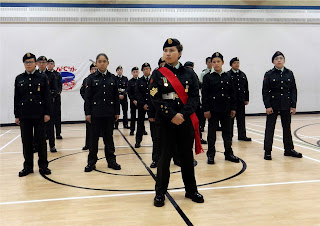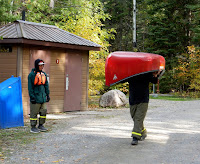October 27 was a busy day for 3045 Army Cadet Corps. The cadets competed in the annual fall biathlon
competition. The timed race would see
cadets shooting plinker targets with pellets and running a 1km course outside. Everyone would shoot three relays, but the
senior cadets would run a third lap. The
junior cadets only had to do two laps.
We have to run the competition in timed relays because the corps only
has three white plinker target boxes.
And it’s easier on the timekeepers & scorekeepers.
The cadets set up the range in Inuujaq School’s gym. Three white plinker targets were placed at
one end of the gym with sandbags weighing them down. Wooden backboards stood behind the targets to
stop missing pellets from hitting the walls.
A line of tables and chairs were placed at the other end of the gym. Air rifles, pellets, shooting mats, and stop
watches were also brought out. I created
& printed score cards for each participating cadet, thus making the
administration’s work easier.
The cadets formed up when all the preparations were
complete. I gave them a short briefing
on how the competition would proceed and how their performances would be
marked. Basically, there would be time penalties
for missed targets and whoever was caught taking shortcuts while running would
have to clean the entire gym at the end of the day. There would be an MRE lunch break and I was expecting
the competition to proceed into the afternoon.
The winners of each section would receive prizes of some sort. The cadets then got into a circle and did
stretches.
 |
| Frank fixes a rifle. |
I was the main scorekeeper & timekeeper. There were enough stop watches to individually
time each cadet. I wanted to avoid
having to do time calculations. I was
grateful that I had Frank to help me out with the competition. He would keep the waiting cadets busy &
distracted while I ran the range. He
also had a few senior cadets at his disposal.
He placed a senior cadet in charge of reviewing air rifle & range
procedures with the junior cadets.
Another senior cadet instructed the junior cadets how to unpack and
prepare their own MRE lunch.
Once the competition began, a pattern quickly developed. Cadets were either shooting, running, waiting,
learning about the Daisy air rifle, and/or waxing biathlon skiis. (The rifle shoots .177 calibre pellets at 495
feet per second. In Canada, an object
that fires a projectile at 500 feet per second or more is classified as a
firearm). Several cadets helped me refill
the pellet bowls and reminded me who was returning to the gym after an arduous
run. The weather was sunny but there was
a lot of snow on the ground. I did
caution the cadets to be careful when running outside.
 |
| Cadets eating lunch. |
Cadets who completed their relays early were treated to
hot chocolate and any remaining MRE rations.
At lunch time, the MRE meals were cooked outside using Coleman stoves. The competition was done by 2:30pm. I double checked all the scorecards before
declaring the competition officially done.
Everyone took part in the cleanup.
Once the everything had been put away, the cadets were brought together
for the debriefing.
Frank & I congratulated the cadets for taking part in
the competition. They were told that the
results would be posted soon. The
original plan was to announce the winners on Wednesday, October 31 but cadets would
be cancelled that day because of Halloween.
We also explained to the new cadets that the Fall Biathlon is a local
event designed to build confidence and to get an idea of what it feels like to
compete in the cadet program.
The cadets were dismissed to play a variety of sports for
two hours in the gym. At the end, Frank
& I handed out corps t-shirts & hoodies. Several photographs were taken of the cadets
in their hoodies for promotional purposes.




























































